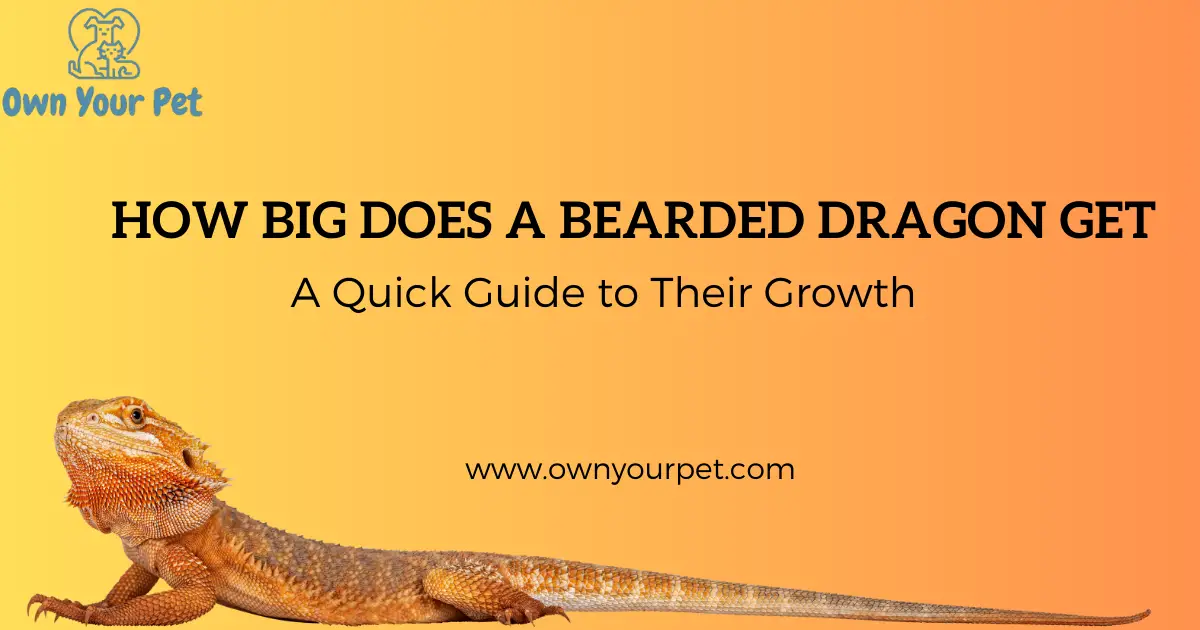Are you one of the proud bearded dragon owners or considering getting one as a pet? One question that often comes to mind is, “How big does a bearded dragon get?” Understanding these fascinating reptiles’ growth and size potential is crucial for providing them with the proper care and habitat.
From their early days as adorable baby dragons to their majestic adulthood, bearded dragons go through a remarkable growth journey. In this article, we’ll explore the average lifespan, growth patterns, and factors that influence the size of these captivating creatures.
Whether you’re a new owner or a seasoned reptile enthusiast, join us as we delve into the fascinating world of bearded dragon growth and discover the answers to your burning questions.
Bearded Dragon Size Overview
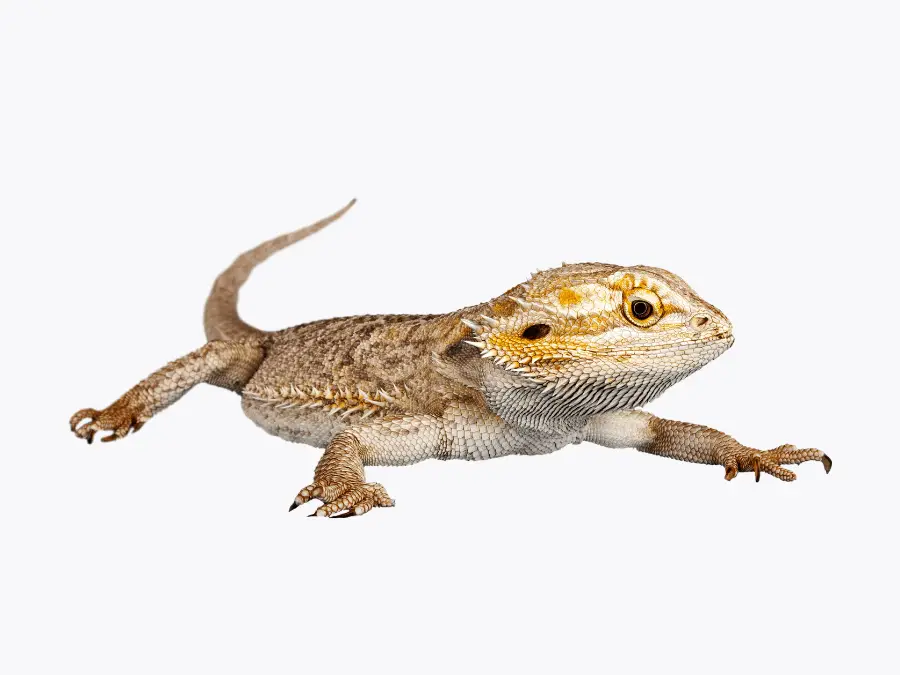
Proper care and the environment are essential for ensuring the healthy growth of your bearded dragon. One crucial element is providing adequate heat through the use of heat lamps, which is a heat source. These lamps mimic the warmth of their natural habitat, helping maintain a temperature gradient necessary for their well-being.
When they hatch, baby bearded dragons size typically measures around 3-4 inches, but they have impressive growth potential. As they progress through their life stage, which averages around 10-15 years, their diet plays a vital role in their growth.
A balanced and nutritious bearded dragon diet consisting of vegetables, fruits, and protein sources is key to their development. Monitoring their growth using a bearded dragon growth chart by growth ranges allows you to track their progress and ensure they are reaching the appropriate size milestones.
As they mature, pet reptile can reach a size of 16-24 inches or even larger, showcasing their remarkable growth potential.
Species and Genetics
Bearded dragons belong to the genus Pogona, which includes eight different species. These species vary in terms of their size and appearance. The most common species in pet trade is the Pogona vitticeps, generally referred to as the Central Bearded Dragon.
The size of a bearded dragon can be influenced by genetics, meaning that the size of its parents will help determine its maximum size. While bearded dragons typically have a range of 18-22 inches from head to tail when fully grown, some individuals might remain shorter due to their genetic makeup.
Gender and Age
The size of a bearded dragon can also be influenced by its gender. Males tend to be longer than females, with an average length of 21 to 24 inches, while females have a slightly smaller length ranging between 16 to 19 inches. Although males are longer, females have broader bodies.
Bearded dragons go through several stages of growth, with the adult stage typically reached between 8-18 months of age. Here is a brief breakdown of their growth stages:
- Hatchling (0-2 months): 2-3 inches in length, weighing 2 ounces.
- Juvenile (2-8 months): Rapid growth during this period.
- Adult (8-18 months and onwards): Growth slows down, with adult bearded dragons reaching between 18-22 inches in length, weighing 13-18 ounces.
Keep in mind that a bearded dragon’s overall size and growth rate depend on several factors, including its diet, health, and living conditions. Providing a proper diet and habitat will allow your bearded dragon to thrive and reach its full potential in terms of size.
Bearded Dragon Growth Rates
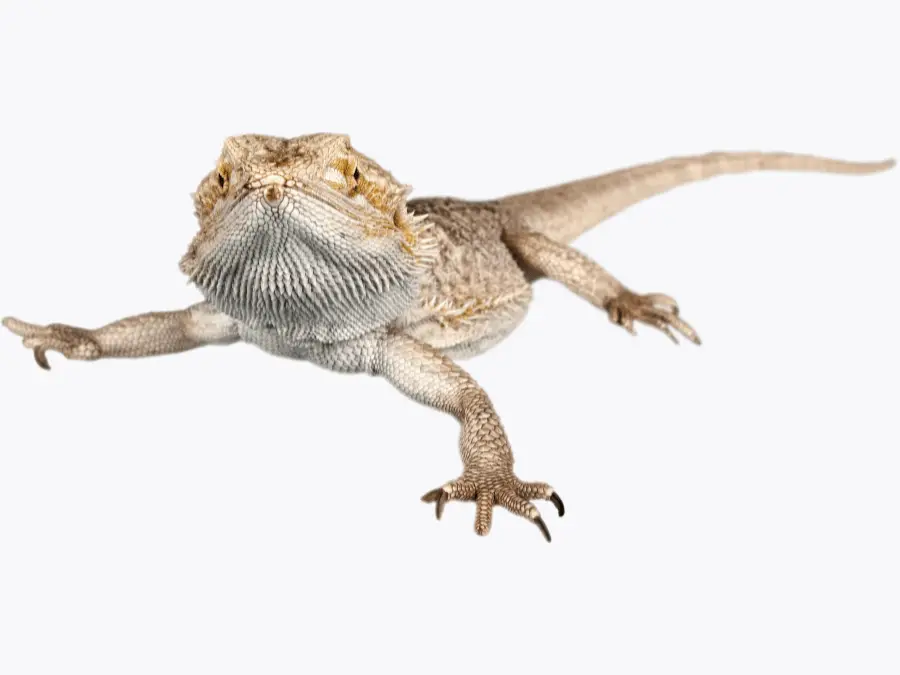
Baby Bearded Dragons
Baby bearded dragons, also known as hatchlings, begin their life at a length of 2-3 inches and a weight of 2 ounces. They experience rapid growth during the first few months of their life, with a monthly growth rate of 1 to 3 inches. Proper nutrition and care are necessary to ensure healthy growth during this phase. Key factors to monitor include:
- Diet: Baby beardies should be fed a mixture of insects and vegetables.
- Temperature: Maintain a temperature gradient in their enclosure, with a basking area around 100°F.
- Hydration: Offer water daily to prevent dehydration.
Juvenile Bearded Dragons
As they grow into the juvenile stage, bearded dragons continue to grow at a steady rate, reaching lengths between 15-24 inches by 1 year of age. It is important to adjust their enclosure size and diet as they grow larger. Key considerations during the juvenile stage include:
- Increased enclosure size to allow for freedom of movement and exploration.
- Continuing to feed a balanced diet of insects and vegetables, while introducing more variety to ensure they receive necessary nutrients.
- Monitoring weight gain to maintain an optimal growth rate.
Adult Bearded Dragons
By the time they reach adulthood, bearded dragons are fully grown at around 18 months old4. Adult bearded dragons generally measure anywhere from 16 to 24 inches in length and weigh between 380 to 510 grams. Their tails account for a significant portion of their length, often being as long, if not longer, than their bodies.
During adulthood, the focus shifts from growth to maintaining overall health and weight. Key factors for adult bearded dragons include:
- Diet: Gradually adjust the ratio of insects to vegetables, offering more vegetables as they age.
- Exercise: Provide climbing branches and hiding spots to encourage activity.
- Health monitoring: Regularly check for signs of illness or injury to ensure a long and healthy life.
In conclusion, bearded dragon growth rates are influenced by factors such as health, diet, and environment. Ensuring proper care throughout each stage of life enables these fascinating lizards to thrive in captivity.
Factors Affecting Bearded Dragon Size
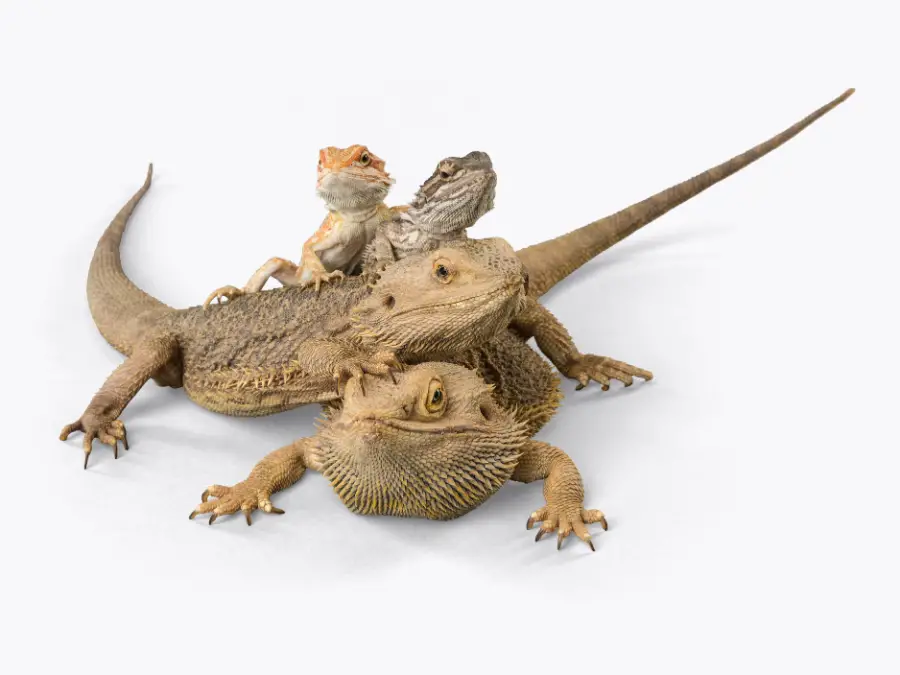
Genetics and Breeds
There are several factors that can influence the size of a bearded dragon, one of which is its genetics and breed. Different species of bearded dragons, such as the Pogona minor mitchelli, Pogona minor, and Pogona microlepidota, tend to vary in size and weight.
The eastern bearded dragon, for example, can grow up to 18-24 inches long and weigh between 0.75-1.25 lbs.
Diet and Nutrition
Another significant factor affecting a bearded dragon’s size is diet and nutrition. A balanced and nutritious diet plays a crucial role in a lizard’s growth and overall health. A proper diet for a bearded dragon should include a variety of protein sources, such as insects and small vertebrates, along with fruits and vegetables to provide essential vitamins and minerals.
Baby bearded dragons benefit from a diet high in protein to support their rapid growth, while adult bearded dragons should have a more balanced diet with a lower protein intake. Proper nutrition not only helps ensure a bearded dragon reaches its full potential in terms of size, but also promotes good health and longevity.
Environment and Habitat
The environment and habitat in which a bearded dragon is kept can also influence its size. In the wild, bearded dragons are native to Australia and thrive in arid environments. In captivity, creating a suitable habitat for your pet lizard is essential by providing an appropriate tank size, substrate, and temperature gradients.
A spacious enclosure allows the bearded dragon to exercise and grow properly, whereas a small tank can limit its growth and cause health problems. Furthermore, maintaining the right temperature and humidity levels can help avoid stress and promote healthy growth for your bearded dragon.
Taking care of a bearded dragon requires attention to factors such as genetics, diet, and environment to support their growth and development. By closely monitoring these factors, pet owners can ensure that their bearded dragons live a healthy and happy life, reaching their full size potential.
Characteristics of Different Bearded Dragon Species
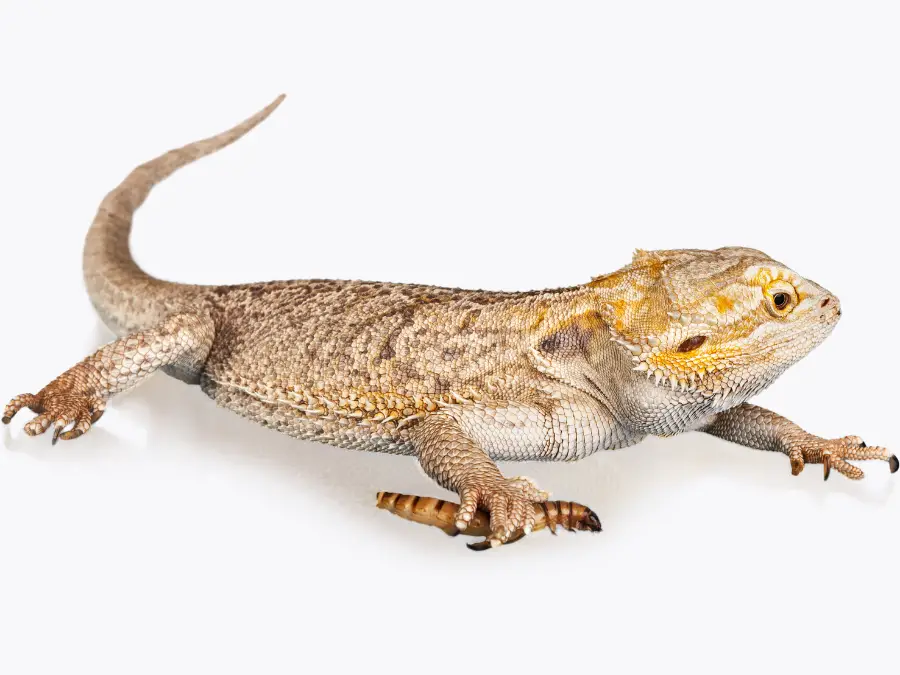
Pogona Vitticeps (Central Bearded Dragon)
The Pogona Vitticeps, or central bearded dragon, is the most common species kept as a pet. It can be found in most of Australia’s dry areas, bush, and forests. This species can grow up to 24 inches in length when fully grown.
Pogona Barbata (Eastern Bearded Dragon)
The Pogona Barbata is also known as the Eastern Bearded Dragon or sometimes the Coastal Bearded Dragon. Like the Central Bearded Dragon, this species can reach a length of 24 inches when fully grown.
Pogona Minor (Western Bearded Dragon)
The Pogona Minor or Western Bearded Dragon is native to Western Australia. This species has not been studied extensively, and information about its size and growth is limited.
Pogona Nullarbor (Nullarbor Bearded Dragon)
The Pogona Nullarbor, also known as the Nullarbor Bearded Dragon, is another relatively understudied species. Its natural habitat is the limestone cliffs and caves of the Nullarbor Plain, hence its name. Due to the lack of research, information about its size and characteristics is limited.
Pogona Henrylawsoni (Lawson’s Bearded Dragon)
The Pogona Henrylawsoni, known as Lawson’s Bearded Dragon, is native to Queensland, Australia. This species is similar to the Central Bearded Dragon but is smaller, maturing at lengths of up to 12 inches.
Pogona Minor Minima (Drysdale River Bearded Dragon)
The Pogona Minor Minima, or Drysdale River Bearded Dragon, is a rare and understudied species. Due to limited information, its size and other characteristics remain poorly understood.
Other Rare Species
There are other rare Bearded Dragon species, including the White Bearded Dragon, which is a rare and unique morph with varying color based on temperature. These rare species are generally not suitable for beginner hobbyists due to their scarcity and specific care requirements.
Common Health Issues Affecting Bearded Dragon Size
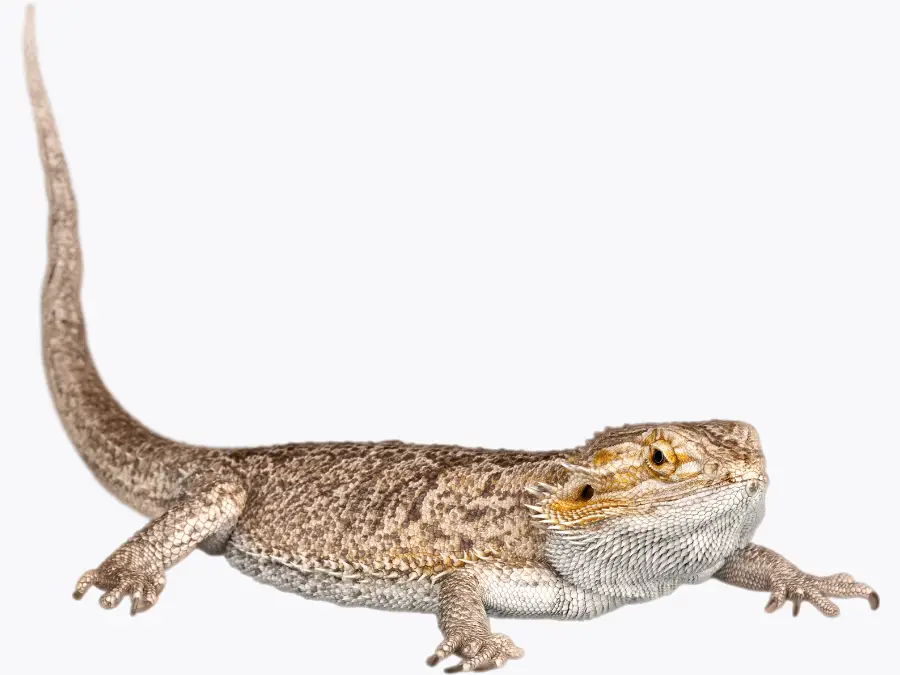
Metabolic Bone Disease
Metabolic Bone Disease (MBD) is a common health problem in pet bearded dragons, especially among the young ones. It is mainly caused by feeding an improperly balanced diet that is high in phosphorus, but low in calcium and vitamin D3.
Lack of exposure to ultraviolet (UV) lighting can also contribute to the development of this disease. MBD leads to a weakened skeletal system, resulting in deformities and stunted growth in bearded dragons.
To prevent MBD, be sure to provide a well-balanced diet with the right balance of calcium and phosphorus, as well as proper UV lighting for your bearded dragon.
Impaction
Impaction is another health issue that can affect a bearded dragon’s growth. It occurs when a bearded dragon ingests indigestible material, such as substrate or large insects, which then leads to a blockage in their gastrointestinal tract. Impaction can cause loss of appetite, lethargy, and eventually stunted growth in bearded dragons.
To prevent impaction, offer appropriate-sized insects to your bearded dragon, and use a safe and digestible substrate in their enclosure.
Stunted Growth
Stunted growth can be caused by several factors, including poor diet, inadequate lighting, or health problems like MBD and impaction. A bearded dragon that is not provided with the necessary nutrients for growth or not properly cared for can experience stunted growth.
To ensure your bearded dragon’s healthy growth, provide a well-balanced diet, proper lighting, and a clean habitat. Regular veterinary check-ups can also help identify potential health concerns before they become serious issues.
Shedding
Bearded dragons go through a shedding process, which is essential for their growth. Problems with shedding can occur if a bearded dragon’s environment is too dry or if they are not receiving proper nutrients. Incomplete or irregular shedding can cause discomfort and negatively impact a bearded dragon’s overall health and size.
To ensure proper shedding, maintain appropriate humidity levels in your bearded dragon’s enclosure and provide essential nutrients through a balanced diet.
How Big Does a Bearded Dragon Get? Watch this
Caring for a Bearded Dragon to Maximize Growth
Proper Diet and Nutrition
To ensure optimal growth for your bearded dragon, it’s crucial to provide a balanced diet. Baby and juvenile bearded dragons require more protein for growth and should be fed daily with a mix of insects (e.g., crickets, mealworms) and vegetables. As they transition into adults, their diet should shift to mostly vegetables, with insects fed less frequently.
The dietary needs of an adult bearded dragon include:
- 80% vegetables (e.g., collard greens, mustard greens, and squash)
- 20% insects (e.g., crickets, mealworms, and phoenix worms)
In addition to a balanced diet, supplementing calcium and vitamin D3 is essential to prevent health issues. For baby bearded dragons, apply supplements daily, whereas juvenile bearded dragons require supplementation 3-4 times per week, and adults need it once a week.
Optimal Enclosure and Environment
Creating a suitable environment for your bearded dragon is essential for them to thrive. Adult dragons need a 75 or 120-gallon aquarium with a screen top, or an enclosure that is at least 48″ long, 24″ wide, and 18″ high. Choose safe substrates, such as reptile carpet or tile, to prevent impaction risks.
Ventilation is crucial to avoid high humidity levels which could lead to respiratory issues. Keep humidity levels below 40% for a healthy environment. Also, place a water dish and a hiding spot in the enclosure to offer comfort and security.
Lighting and Temperature
Proper lighting and temperature are essential for bearded dragon growth. They need 10-14 hours of UVB lighting daily, which enables them to synthesize vitamin D3 and properly absorb calcium.
Maintain a temperature gradient in the enclosure with a basking bulb:
- Basking spot: 95-105°F (35-40°C) for adults, 100-110°F (37-43°C) for juveniles.
- Cooler side: 75-85°F (23-29°C) at daytime, 65-75°F (18-24°C) at night.
Never use heated rocks, as they might cause burns. Instead, use ceramic heat emitters for nighttime heat.
Monitoring Health and Growth
Bearded dragons reach a size of 15-26 inches, with their growth dramatically slowing down after 18 months. Monitoring their health is essential to ensure proper growth.
Regularly check for signs of illness, such as lethargy, loss of appetite, irregular droppings, or difficulty breathing. Listen for wheezing or gasping as it could indicate respiratory issues. Adequate shedding is also a good indicator of proper growth and health.
In conclusion, providing proper diet and nutrition, appropriate enclosure and environment, adequate lighting and temperature, and monitoring their health will help ensure your bearded dragon reaches its maximum size and stays healthy.
Determining Bearded Dragon Gender and Weight
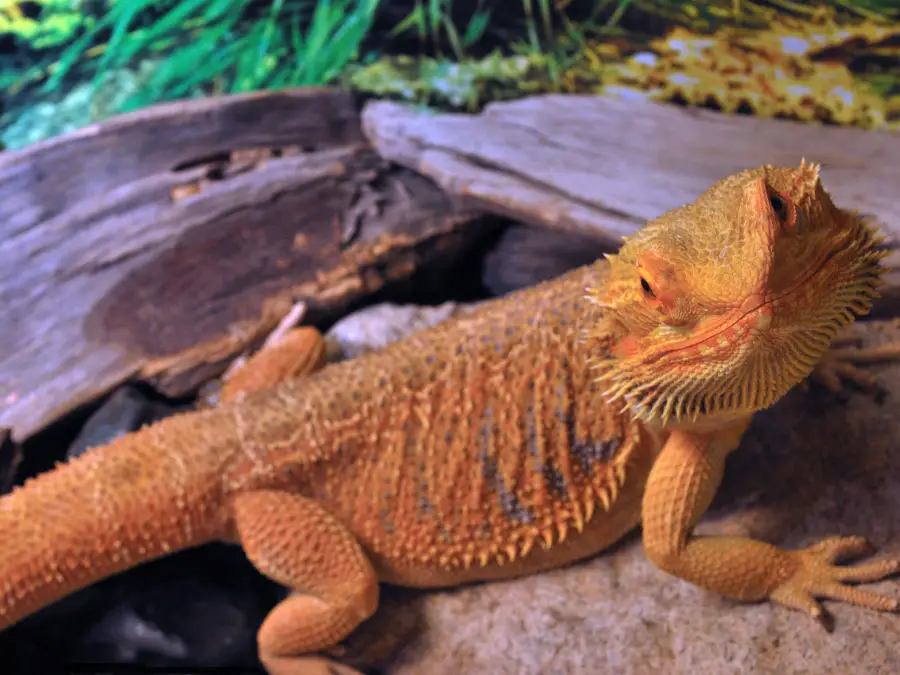
Sexual Maturity and Territorial Behavior
Bearded dragons display certain behaviors when they reach sexual maturity, which can influence their overall size as well as weight. Male bearded dragons are generally more territorial and may exhibit head-bobbing or aggressive posturing.
Females, on the other hand, may display passive or receptive postures. These behaviors can provide clues to their gender, but examining their physical characteristics, such as hemipenal bulges and femoral pores is most accurate.
Comparing Size to Growth Charts
Bearded dragons grow at different rates depending on their age, diet, and overall health. A bearded dragon size chart can be a helpful reference for owners to determine the typical size range for their pet based on its age:
- 3 Months: 7-11 inches
- 6 Months: 11-16 inches
- 9 Months: 13-19 inches
- 1 Year: 15-24 inches
- 18 Months: 15-26 inches
Comparing the bearded dragon’s size to this chart can be beneficial in understanding if they are growing at a healthy and normal rate.
Bearded Dragon Weight Chart
Monitoring a bearded dragon’s weight is crucial for ensuring its overall well-being. A bearded dragon weight chart helps track the optimal weight range according to their age:
3-11 Months:
- Minimum Weight: 25 grams
- Maximum Weight: 400 grams (up to 450 grams in some cases)
If the bearded dragon’s weight is above or below this range, it is a good idea to consult a veterinarian for further guidance.
Remember that these charts are just references and individual bearded dragons may vary. Monitoring your bearded dragon’s growth, weight, and overall behavior will help you cater to their needs and ensure a healthy and active life.
Conclusion: How Big Does a Bearded Dragon Get
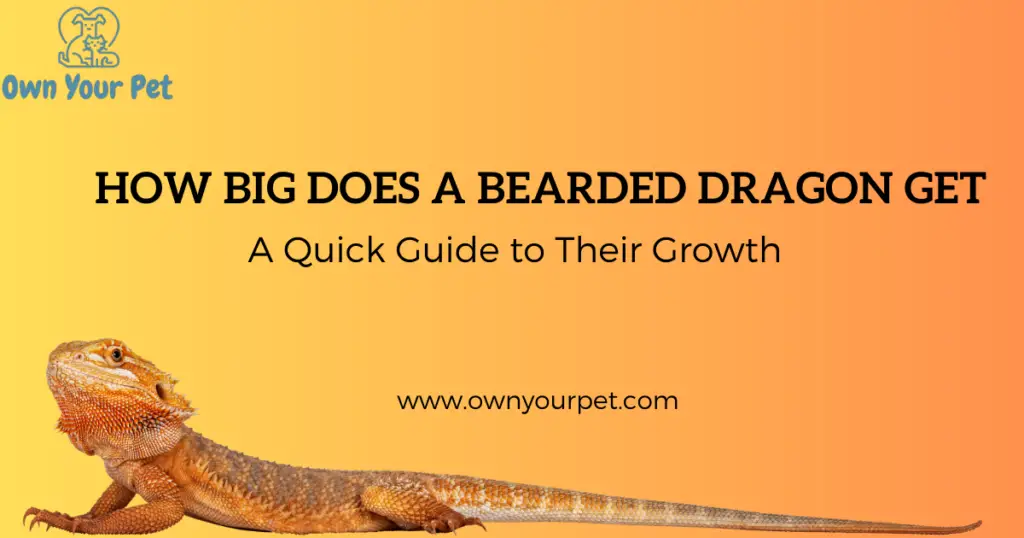
Bearded dragons can reach an average length of 12 to 24 inches when fully grown. Their size is measured from head to tail and may vary depending on the species and gender of the Pogona. Age, genetics, and diet can also influence the growth of these reptiles.
By the time a bearded dragon reaches one year of age, they should measure approximately 15-24 inches. Providing young beardies with protein-rich insects is important to ensure proper growth. Remember that bearded dragons’ growth tends to slow down after one year.
To monitor your bearded dragon’s growth, use a measuring tape and a medium-sized kitchen scale. Weigh them monthly and track their progress using a growth chart for reference. This helps in detecting any potential health issues related to growth.
Remember to take proper care of your bearded dragon by providing an appropriate enclosure, sufficient food, and ample space to grow. Understanding your pet’s growth pattern will ensure their well-being and allow you to enjoy their companionship for many years.
